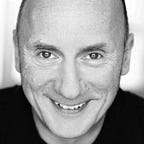Get Into the Flow
„How can I get more productive?“ and „How can I get my work and life into a balance?“ are modern versions of the age old question of „How to lead a good life?“ Being productive, having work-life balance are deemed to be signs of happiness.
But what does that actually mean? Is it just a „feeling“? And what to think of all the good advice floating around on the internet? What should you really, really do to become happier?
If you’re not sick of the myriad recommendations on this matter and are open to yet another perspective, here’s my take on it:
Happiness is a matter of flow.
Yes, I think in the end it pretty much boils down to that. At least „modern happiness“, the one where productivity and work-life balance are of importance, is about flow.
And what is this „flow“, which is a term that has been around since Mihaly Csikszentmihalyi wrote his same titled book? To me it’s much less than the deep mental state described by him. To me it’s very simple:
Flow is the opposite of stress.
When „things are flowing“ you don’t feel stressed. When you don’t feel stressed, you’re happy. It’s that simple.
That’s why Dave Allen advertises his book „Getting Things Done“ as „The Art of Stress-free Productivity“.
Stress is counter-productive for almost everything you’re trying to accomplish, be that preparing a dinner for your spouse, writing a novel, putting together a report for your manager, giving a haircut, or doing research for your master thesis.
Stress is not fun. Stress makes your work and your life harder than desirable.
But from a psychological point of view I think „stress-free“ is a phrase less helpful than intended. It still carries with it the state you want to avoid. It’s the same as if you told yourself „I want to smoke less!“ — which is much less powerful than „I want to be able to breath freely even after climbing the stairs!“
So if you’re on a quest for productive work-life balance then don’t look for stress reduction techniques. Look for methods which increase flow.
For that, though, I think it’s helpful to reflect for a moment on what (psychological) stress is in the first place. Again, let’s keep it simple and way shorter than Wikipedia has it:
Stress means being in conflict.
You feel stressed, when your boss suddenly shows up and wants you to finish a task earlier. You feel stressed when you realise you need information to finish a task on time, but don’t have that information. You feel stressed when your loved one surprises you with a visit and your home is messy. You feel stressed when your car breaks down and it’s close to the end of the month so you’re short of money to get it repaired.
These and millions of other situations are stressful to you because of the nature of conflict (thanks to Janell Klein for pointing that out):
Conflict arises when reality and expectation differ.
When you need to finish a task earlier your expectation (initial deadline) is different from reality (new deadline). The sudden reality of the need to get your car repaired certainly is in stark contrast with your expectation of how you wanted to spend your remaining salary that month.
Now let’s combine the previous two definitions:
Stress arises when reality and expectation differ.
Does that ring true to you? At least it does to me. I always feel stressed when I want to work on a task but cannot, because it turns out something is different than expected. Some prerequisite is not met, some unforeseen dependency arises, some information is lacking, some resource is missing… you name it.
Stress is about a surprising contrast. Map and terrain don’t match. Plan and reality collide. That’s frustrating, sometimes infuriating. Certainly it’s a dip in happiness.
So what can you do to increase happiness, to become more productive and more work-life balanced? Let’s meld together the new definition of stress with the definition of happiness at the top:
Happiness is a matter of keeping reality and expectations matched.
As long as your expectations and reality match you are living in a simple state of flow. Your life is running smoothly. Thinks are working out.
And from this follows very, very simple advice to improve whatever you’re trying to improve: productivity, work, life, work-life and whatnot. Start with this:
Become sensitive for large and small conflicts.
It’s basic mindfulness. Learn to see all the expectations you have — and how reality is in alignment with them or not. First just observe.
Later move to the next level. Try to see the patterns. Reflect on the severeness of conflicts. Focus your improvement efforts on the most frustrating ones first.
And then, when you pick up a technique you read about, a method your friend has recommended, ask yourself: In what way does this approach try to increase flow? What kind of conflicts does it address?
Look at Tiago Forte’s P.A.R.A method or Dave Allens GTD or the Eisenhower Matrix or Activity Sampling etc. Look closely! Try them out! And be very, very conscious about the conflicts you run into (or which you don’t run into anymore).
To me the only metric for the effectiveness of any approach to improve your life is: number of conflicts. Does an approach reduce the number of conflicts over time and on average? If yes, good. If no, try something else. (Or become better at it.)
Or to phrase the metric more positively: Does an approach increase flow?
Yes, I think that’s the main question you should try to answer on your quest for „modern happiness“. If becoming more productive, if better work-life balance is your goal, then you want to start flowing in that direction.
That’s why I named this medium publication „Personal Flow“. Whatever I’m writing here is supposed to increase your sense of life flowing more easily.
